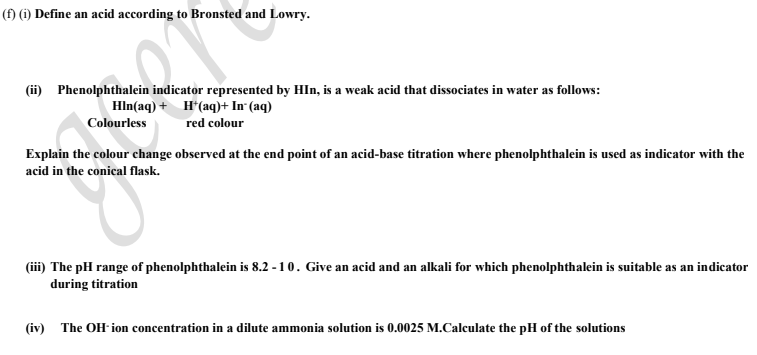(ii) Phenolphthalein indicator represented by HIn, is a weak acid that dissociates in water as follows: Hln(aq) + H*(aq)+ In (aq) Colourless red colour Explain the colour change observed at the end point of an acid-base titration where phenolphthalein is used as indicator with the acid in the conical flask.
(ii) Phenolphthalein indicator represented by HIn, is a weak acid that dissociates in water as follows: Hln(aq) + H*(aq)+ In (aq) Colourless red colour Explain the colour change observed at the end point of an acid-base titration where phenolphthalein is used as indicator with the acid in the conical flask.
Principles of Modern Chemistry
8th Edition
ISBN:9781305079113
Author:David W. Oxtoby, H. Pat Gillis, Laurie J. Butler
Publisher:David W. Oxtoby, H. Pat Gillis, Laurie J. Butler
Chapter15: Acid–base Equilibria
Section: Chapter Questions
Problem 99AP
Related questions
Question
Answer (i) & (ii) showing all steps

Transcribed Image Text:(f) (1) Define an acid according to Bronsted and Lowry.
(ii) Phenolphthalein indicator represented by HIn, is a weak acid that dissociates in water as follows:
Hln(aq) + H*(aq)+ In (aq)
Colourless
red colour
Explain the colour change observed at the end point of an acid-base titration where phenolphthalein is used as indicator with the
acid in the conical flask.
(iii) The pH range of phenolphthalein is 8.2 - 10. Give an acid and an alkali for which phenolphthalein is suitable as an indicator
during titration
(iv) The OH- ion concentration in a dilute ammonia solution is 0.0025 M.Calculate the pH of the solutions
Expert Solution
This question has been solved!
Explore an expertly crafted, step-by-step solution for a thorough understanding of key concepts.
This is a popular solution!
Trending now
This is a popular solution!
Step by step
Solved in 3 steps

Knowledge Booster
Learn more about
Need a deep-dive on the concept behind this application? Look no further. Learn more about this topic, chemistry and related others by exploring similar questions and additional content below.Recommended textbooks for you

Principles of Modern Chemistry
Chemistry
ISBN:
9781305079113
Author:
David W. Oxtoby, H. Pat Gillis, Laurie J. Butler
Publisher:
Cengage Learning

Principles of Modern Chemistry
Chemistry
ISBN:
9781305079113
Author:
David W. Oxtoby, H. Pat Gillis, Laurie J. Butler
Publisher:
Cengage Learning